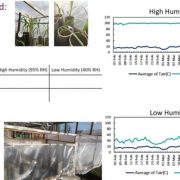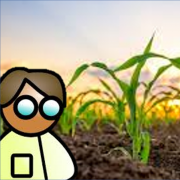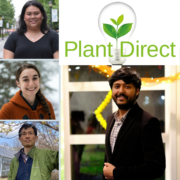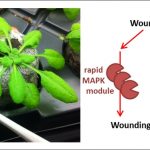Informational Interview with Dr. Margaret Woodhouse: Computational biologist and sequence curator at MaizeGDB
Informational Interview by Samantha Snodgrass, ASPB Conviron Scholar 2020
Margaret Woodhouse is a computational biologist and sequence curator at the Maize Genetics and Genomics Database, MaizeGDB, which is a part of the United States Department of Agriculture, USDA. We talked about her journey to her current position, what work as a MaizeGDB curator is like in the era of genomic data, and her advice to current students exploring career options.
How did you get into this field? What path led you to this position?
I wish I had known about USDA jobs earlier!
Maggie studied art in high school and junior college but didn’t see herself continuing an artist career. She started working at the UC Berkeley designing buildings and became interested in landscape architecture. It was there that she found plant biology. “That was the one that stuck,” she remarked. The sciences initially turned her off because she thought all scientists had to have type A skills. Proving that idea wrong became a motivation as she entered graduate school. While in graduate school, she took a genetics class by Mike Freeling which “blew my mind open.” She did graduate work on the epigenetic control of TEs in maize followed by a postdoc at UC Davis on polyploidy. She came back to Berkeley to work in Freeling’s lab on comparative genomics. Because of her genetics background, “you can do a reality check, ground truth [the bioinformatics].” Through this work she learned bioinformatics. She knew that she did not want to be a professor, and at the annual maize meeting MaizeGDB advertised a computational biologist position. While all of her experiences helped make her a better scientist, she wished she had known about USDA jobs earlier.
Can you tell me about your current responsibilities?
A curator acts as a bridge between community members and large databases.
At her current job one of her main responsibilities is to curate maize genomic data. This can include new genome assemblies, RNA seq, or epigenomic datasets in maize. She reads the literature to decide what is useful or novel about new datasets and if it is something MaizeGDB would host in their database. She maps or re-maps data to a reference coordinate system to keep the database consistent. Tool development is another one of her responsibilities. She will look for useful tools that have already been built as well as work with other MaizeGDB scientists to create new ones. These tools allow data to be visualized in useful ways. She collaborates with different research groups and interacts with stakeholders. This is usually through email, conferences, or meetings. She can also assist with submitting data to NCBI or EBI which are larger databases that have specific formats and requirements for data submission.
What kinds of experience help prepare for this kind of job? Classes, skills, degrees?
Knowing how the data is generated helps later bioinformatic analyses: “all of it”
Even though she doesn’t do bench or field work anymore, it leads up to the genomic data she uses. By better understanding where the data comes from, she can act as a bridge between computational and benchwork biologists. She can also remember what it’s like to not know bioinformatics and how intimidating that can be to newcomers. She is a self-taught bioinformatician and learned her computational skills through doing. While the logic of programming languages doesn’t change, the software changes drastically (except bedtools, blast, and dagchainer). In those cases, she thinks it would be more helpful to have programming classes that teach the logic behind a language rather than specific programs.
What is the atmosphere/culture of your workplace?
“I’m really happy to be working in MaizeGDB!”
MaizeGDB is full of good people who are “collaborative and really nice”. They’re all positive, and the environment is quite nurturing. The USDA has stable and reliable funding throughout their five-year plans. Research is kept on track through writing annual reports. They have job security with good benefits and room for advancement. There are lots of good people and research scientists to interact with at the USDA. From her local observations, if you do good work you will be rewarded. Aside from the financial benefits, it’s nice to get the acknowledgment for her work.
Who do you frequently work with? What are the kinds of things that they do?
She works with many outside research groups and databases to ensure connectivity throughout the maize community.
Outside of MaizeGDB, she works often with other research groups like Matthew Hufford at Iowa State University, who sequences lots of maize genomes. She also has one-off interactions with people who have data and would like to find the best way to make it a part of MaizeGDB. She also works with Gramene, a separate database, so that their two databases can be connected to each other. She works with Roger Wise for plant disease resistance and Caroline Lawrence-Dill, who is the former research lead for MaizeGDB and still produces research and bioinformatic tools for the community.
Is this a rapidly growing field? How do you predict demand for this kind of work will change overtime?
With more big datasets being released, we need more curators to manage them.
“We always need more curators but it’s difficult,” she says. Without an intense research component, it can be hard to get PhD level workers to these positions. While being a curator does require training, a PhD might not be prerequisite for the position. She sees the need increasing with more genomic data becoming available, as curators need to parse out high quality data and present it in efficient ways to the community. Although there’s uncertainty as to what the openings will be like, there will likely be increased demand for this kind of work. She wishes more people knew about this potential career path.
Have I left out any important questions that would be good to ask?
Go explore career options every chance you get!
She wishes more universities offered more career exploration to their students. It can be hard to find out about the opportunities so definitely look for those chances to explore.








